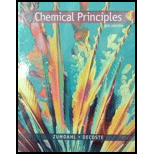
Concept explainers
(a)
Interpretation: The percent ionization of 0.10 M
Concept Introduction: A base is the substance that gives
The base dissociation constant is the ratio of concentration of product and reactant for the equilibrium reaction of weak base in solution. For the given weak base BOH, it can be written as:
The percent ionization can be calculate with the help of concentrations value:
(a)
Answer to Problem 85E
Explanation of Solution
The equilibrium equation can be written as:
Concentration of
The equilibrium and
Make ICE table:
| Concentration | |||
| Initial | 0.10 | 0 | 0 |
| Change | -x | x | x |
| Equilibrium | 0.10 −x | x | x |
Substitute the values to calculate ‘x’:
Calculate the percent ionization:
(b)
Interpretation: The percent ionization of 0.010 M
Concept Introduction: A base is the substance that gives
The base dissociation constant is the ratio of concentration of product and reactant for the equilibrium reaction of weak base in solution. For the given weak base BOH, it can be written as:
The percent ionization can be calculate with the help of concentrations value:
(b)
Answer to Problem 85E
Explanation of Solution
The equilibrium equation can be written as:
Concentration of
The equilibrium and
Make ICE table:
| Concentration | |||
| Initial | 0.010 | 0 | 0 |
| Change | -x | x | x |
| Equilibrium | 0.010 −x | x | x |
Substitute the values to calculate ‘x’:
Calculate the percent ionization:
(c)
Interpretation: The percent ionization of 0.10 M
Concept Introduction: A base is the substance that gives
The base dissociation constant is the ratio of concentration of product and reactant for the equilibrium reaction of weak base in solution. For the given weak base BOH, it can be written as:
The percent ionization can be calculate with the help of concentrations value:
(c)
Answer to Problem 85E
Explanation of Solution
The equilibrium equation can be written as:
Concentration of
The equilibrium and
Make ICE table:
| Concentration | |||
| Initial | 0.10 | 0 | 0 |
| Change | -x | x | x |
| Equilibrium | 0.10 −x | x | x |
Substitute the values to calculate ‘x’:
Calculate the percent ionization:
Want to see more full solutions like this?
Chapter 7 Solutions
CHEM.PRINC.W/OWL2+REBATE+2 SUPPL.>IP<
- State whether 1 M solutions of the following salts in water are acidic, basic, or neutral. (a) K2CO3 (b) NH4F (c) LiH2PO4 (d) NaNO2(e) Ba(ClO4)2arrow_forward. Strong buses are bases that completely ionize in water to produce hydroxide ion, OH-. The strong bases include the hydroxides of the Group I elements. For example, if 1.0 mole of NaOH is dissolved per liter, the concentration of OH ion is 1.0 M. Calculate the [OH-], pOH, and pH for each of the following strong base solutions. a. 1.10 M NaOH b. 2.0104M KOH c. 6.2103M CsOH d. 0.0001 M NaOHarrow_forwardCalculate the pH of the following solutions. a. 0.10 M NaOH b. 1.0 1010 M NaOH c. 2.0 M NaOHarrow_forward
- Write a formula for the conjugate base formed when each of the following behaves as a Brnsted acid: a. HSO4 b. CH3NH3+ c. HClO4 d. NH4+ e. HClarrow_forwardThe ideal pH of a swimming pool is 7.2. You measure the pH of your pool to be 6.5. What should you add, acid or base, to restore your pool to the ideal pH? acid base neitherarrow_forwardA 0.365-g sample of HCl is dissolved in enough water to give 2.00 102 mL of solution. What is the pH? (a) 2.000 (b) 0.0500 (c) 1.301 (d) 1.000arrow_forward

 ChemistryChemistryISBN:9781305957404Author:Steven S. Zumdahl, Susan A. Zumdahl, Donald J. DeCostePublisher:Cengage Learning
ChemistryChemistryISBN:9781305957404Author:Steven S. Zumdahl, Susan A. Zumdahl, Donald J. DeCostePublisher:Cengage Learning Chemistry: An Atoms First ApproachChemistryISBN:9781305079243Author:Steven S. Zumdahl, Susan A. ZumdahlPublisher:Cengage Learning
Chemistry: An Atoms First ApproachChemistryISBN:9781305079243Author:Steven S. Zumdahl, Susan A. ZumdahlPublisher:Cengage Learning Chemistry for Today: General, Organic, and Bioche...ChemistryISBN:9781305960060Author:Spencer L. Seager, Michael R. Slabaugh, Maren S. HansenPublisher:Cengage Learning
Chemistry for Today: General, Organic, and Bioche...ChemistryISBN:9781305960060Author:Spencer L. Seager, Michael R. Slabaugh, Maren S. HansenPublisher:Cengage Learning Chemistry: Principles and ReactionsChemistryISBN:9781305079373Author:William L. Masterton, Cecile N. HurleyPublisher:Cengage Learning
Chemistry: Principles and ReactionsChemistryISBN:9781305079373Author:William L. Masterton, Cecile N. HurleyPublisher:Cengage Learning





